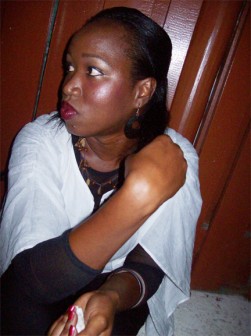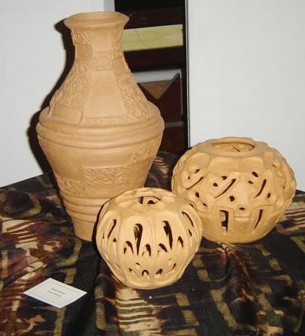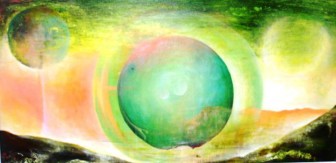By Jairo Rodrigues
Jynell Osborne expresses her deepest thoughts in magnificent works of art. A painter by nature, an expressionist by heart, her style as an expressionist and an abstractionist causes her brushes to swirl in a balance of colours and life as she depicts social issues and cultures of Guyana. The techniques she uses are scumbling, glazing, wet-into-wet or a combination.
“I am not a very public person but I have things to say, so I express them through my art,” Jynell told The Scene in an interview. “I look at things through an expressionist light and manner. I try my best to express it, produce work that is going to reflect my thoughts on a specific issue. I am not concerned with correctness – just expression. The forms I use are very strong and I simplify and eliminate for my perfection. Colour is important to me, since I express a lot of myself through the energy of colours; you can never get rid of colour it is just recycled.”

Her parents were originally coastlanders, but ventured to the south of Guyana and settled in Lethem. Although she was born in the capital at the Georgetown Public Hospital, she was raised in their family home in the Rupununi village where she enjoyed open spaces and family values.
She said her parents made it their business to send her and her four other siblings somewhere on holidays. They would often visit relatives in neighbouring Brazil, in the city, at Linden or New Amsterdam, so in many ways she has experienced the diversity of Guyana.
In comparing visiting towns and growing up in a rural environment she said that growing up in the interior had more structure. “We had the basic infrastructure like schools and hospitals but it was so much more! There were tree climbing, rolling in the sand, climbing the ants’ nests, running in the savannahs – the world of recreational activities. Because of our simplicity in living, we grew up with a clear vision: education had a place, spiritual belief had a place and social life had a place… It was never really about money because we stayed focused on the important things in life,” she said.

She is the penultimate child of the five children her parents raised. “I was in the position where everything that my bigger sisters outgrew, I got and everything that was too small for my younger sister, I got, so it was a good position to be in,” she said.
She grew up in a household where her parents always gently instilled values and morality in every aspect of life. She said that it was a calm Christian household but her parents were never the Bible-thumping kind of people; they just laid out a path of what was acceptable and what was not.
Jynell said that in Lethem at that time extended families were not as common as in the city. Her closest relative was her grandmother who lived five miles away so they seldom saw her except for Sunday church sessions.
When they did get to visit her, they would eagerly await the sound of snores which would indicate that her grandmother was asleep, then, as she puts it, “We had enough time and space to make mischief.”
Frying cashew nuts, climbing trees and enjoying the creeks were the enjoyments of those days.

In contrasting to her open Rupununi spaces, she said that while visiting relatives in David Street, Georgetown she could literally look into their neighbour’s house. Fondest memories in the city would be eating tennis rolls which they considered a delicacy since they were none in Lethem, crossing the ferries and visiting “Coney Island”. She said, “You had perspective (growing up in the rural world). Up to now when I visit the Georgetown markets it is a thrilling experience for me because in Lethem the market was different. It is not surprising that I am an artist because I have always observed the way people move around and had that appreciation for my environment.”
She expressed that she had somewhat an interesting secondary school life. After attending St Ignatius Secondary in Region Nine for five years, she was on the brink of completing her schooling at 15 when her family decided to move to the city. She transferred to Cummings Lodge Secondary School, where streaming was done (something not offered in Lethem), the school advised her to repeat from Form Three so she would have the opportunity to stream into her preferred subjects. With disappointment she agreed and went into the Science stream where she took up Art and Geography as make up subjects. She eventually finished secondary school at eighteen and with nine passes in the CSEC Examinations.
Because she was unable to complete Chemistry in secondary school, going into the Science course at the University of Guyana was troublesome, so she took Art as a backup course while waiting to be admitted into Chemistry. Eventually her love for art grew stronger so she continued to do the course and graduated with Honours.

At least twice she had the opportunity to go to Tougaloo College in Jackson, Mississippi, United States to study the fine art of almost-instant jewellery and acoustic painting – an ancient Egyptian method of painting. She said she experienced a lot in the community since it is very historic and has a lot of monuments of African freedom and African heritage.
She was always keen when it came to art. “It started when I was very young, I fondly remember when I graduated from nursery school my prize was an art book that was as tall as I was, which came with a big box of crayons. I have fond memories of sitting down on our veranda which faces the west and every evening I sat and tried to copy the impression I got from the sun I saw setting,” she said.
Her parents were always supportive and excited about their daughter’s art. Even before the age of ten, young Jynell would sit and whirl a string of copper wire to make a miniature bicycle; she had made tea pots and cups out of clay and always found creativity in paint and colours. “I was always an explorer, that’s why I am so fond of biology and physics… even art is an exploration for me. Everyone is creative but I always had that instinct to create expressions.”
She always had that natural instinct of creation but it was not until Third Form in Georgetown that she was taught the primary basics of art. Her art teacher at that time was a graduate of Burrowes School of Art and he immediately recognised the passion that she had, so he nurtured her talent.
Artists whose works stimulate her senses are Munch, Courbet, Goya, Van Gogh, Kenwin Critchlow and Bernadette Persaud.
Asked what inspires her true art form, her expressions through paint and colours and her drive to bring out creations through ceramics and textile, she said, “Greatest inspiration always comes from your surroundings. Before 2008 I would have been painting a lot of fauna, now unconsciously the inspiration comes from social issues. I find that I have to represent what is going on around me – it is unavoidable. I observe what is going on in the news, media and other sources and I would address them through my art.”
When asked what she considers to be her most accomplished piece, she said, “I would be a little fickle if I could have answered that. As a teacher I know that each art form is unique and special in its own way. I want my art work to be a certain standard. I form for myself. I want it to interpret my feelings accurately. There is a merit for me in all of them. If I am not happy with a painting I rework it until I am satisfied.”
Jynell was a member of the Guyana Women Artists’ Association (GWAA) since 2002, and was elected president in 2010.
“The GWAA has evolved in a good sense,” she said. “The women who are here are mostly self-taught and a lot of them are pursuing art more seriously. There is a lot of merit, keen eye and creativity in the love for art – from starting simple the women individually and collectively are improving their talents. We are now doing more community work, community service, conducting workshops, exhibitions and facilitating programmes.”
Jynell believes that art needs to be a priority in the education system. “No educational institution should try to force learning to a child. We learn through our senses – instead of drawing a shape on the blackboard, why not take the children out to see the shapes. In order to teach any subject, art and creativity need to be applied. Once you are exposed to that, then you blossom. After all, it is how you deliver what you deliver.”
She continued to say, “In echoing the sentiments of many art educators, we have to re-educate our society on what the visual arts are. There is a generation right now that needs to be educated through and on the principles of art which is an approach we must use.”
Jynell is currently a teacher at the Burrowes School of Art. In the future she sees herself as an established social commentator. “I want my work to be social commentary. The public must be able to look into Osborne’s work and see what it represents in society, what she is trying to say,” she said.









